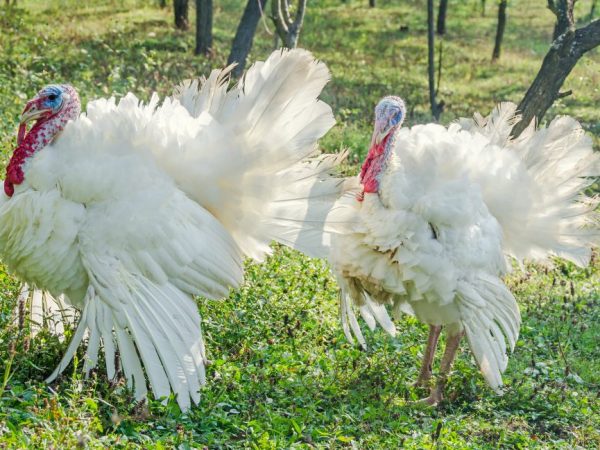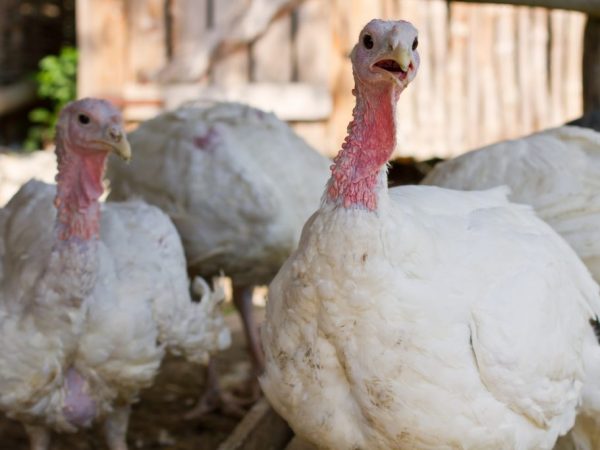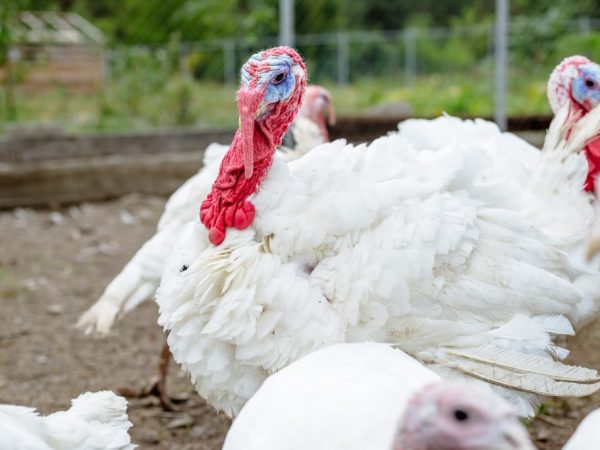Growing Big 6 turkeys at home
Big 6 turkeys (or cross big 6) are a relatively new breed that appeared no more than 10 years ago. But in this short period of time, this bird has managed to gain considerable popularity among farmers throughout the country. A feature of the Big 6 breed is its high productivity. In this case, we are talking about both meat and egg productivity. In addition to food, Big 6 broiler turkeys provide feathers and down, which are used to make pillows and blankets.

Growing Big 6 turkeys at home
Characteristics of big 6 turkeys
Big 6 turkeys are visible on the farm yard from afar. They have a lush and long white plumage. Low paws support a massive and stocky body. The small head of big 6 turkeys is pigmented in red, the intensity of which varies depending on the condition of the bird. The skin around the eyes has a bluish tint.
Big 6 turkeys have a wide and slightly protruding chest. They have thick legs, which, however, is due to their large body weight. The wings and tail, to match the whole body, are large. The head and neck are adorned with red earrings and beard. But the presence of jewelry on the neck and head suggests that there is a male in front of you. Females do not have them.
This breed is often bred specifically to obtain feathers and down. In addition to being long, the soft feather is also extremely light. it broiler breed... Like everyone else, Big 6 broiler chicks mature very quickly. They gain weight in just a couple of months. After that, the bird is slaughtered.
Meat productivity
Males and females differ significantly in weight. Broilers of the Cross Big 6 breed grow up to 11 kg for females and up to 25 kg for males. Perhaps only the Canadian turkey is gaining more weight during growth (males weigh 30 kg, and females weigh 15 kg).
Males are bred for the sake of tender and tasty meat, and females also give eggs. In just a couple of months, one female, with proper maintenance, is capable of producing more than 100 eggs. Turkey eggs are not only large, but also have a spicy taste. Turkeys begin to lay at 8-9 months of age.
Meat productivity is determined not only by live weight, but also by the mass yield after slaughter. In a Big 6 turkey, this yield is 75-80%, which is considered an excellent indicator. This figure is due to the fact that 1/3 of the total weight is the sternum, which has practically no waste.
Conditions for keeping turkeys
First of all, you need to prepare mentally. Turkeys, like any other native bird, need high-quality care. In addition to the time, which will take a lot, you need to prepare for the monetary costs. To achieve the desired weight gain, birds need to provide good food (including booze and vitamin complexes), which is not cheap. And in case of illness, you will have to spend money on medicines. But, after slaughter, all costs will not only pay off, but also bring profit.
The Big 6 turkey breed is not particularly demanding in terms of content. They need approximately the same conditions as chickens.
- The poultry house should be warm and closed. In the cold season, you need to maintain the temperature at 18-200C. Although, the bird feels comfortable enough at 150C. But below this indicator, the thermometer should not fall. As for small turkey poults, they need to provide a temperature of 350C. We will talk in more detail about how to care for young animals later. When raising Big 6 turkeys, take into account the fact that they do not tolerate temperature fluctuations. Therefore, the same temperature regime must be maintained in the poultry house throughout the year.
- Install artificial light sources in the house. The egg production of birds depends on the length of daylight hours. It is advisable to automate the lighting system. This will greatly simplify maintenance.
- Equally important is the proper equipment of the house. If there are not enough containers for food and feed for all birds, then some of them will begin to starve, which will negatively affect both weight gain and health. Also, the lack of feeders or drinkers can provoke fights among birds that are difficult in nature, which will not have the best effect on their productivity.
- Feathered need to clean their plumage. Otherwise, there is a risk of the appearance of various parasites that spoil the feathers of turkeys (peroed, for example). Turkey feathers are cleaned in sand and ash. Therefore, the poultry house should constantly contain containers with sand and ash.
- It is very important for bird health to keep the house clean. The litter changes as it gets dirty, but at least once every 3-4 days.
- Dampness and high humidity have a negative impact on the health of birds. Therefore, we systematically ventilate the house, even in the cold season.
Feeding

You need to feed more than one type of grain
The diet of turkeys consists of mash. You can cook them yourself, or you can purchase ready-made feed... Choose compound feed according to the age of the birds. For youngsters, starting compositions are made separately (they contribute to rapid growth). In addition to compound feed, we give the birds wheat, corn and barley. The technology for preparing turkey mash does not involve the addition of a large amount of water. The porridge should remain crumbly. If balls can be made from it, then it is not suitable for feeding a bird.
The winter diet includes carrots and beets, which must first be chopped on a grater. Also, it will not be superfluous to give the turkeys fish oil and mountain ash. Also in winter we give hay and silage to the birds, harvested in summer. The daily norm of silage, to which we gradually accustom the turkey poults, is 70-80 g.
It is not forbidden to add fermented milk products in small quantities to dry food. Do not mind eating turkeys and onions. But it must first be crushed.
In winter, we feed the birds 3 times a day, in summer we feed the birds 4 times. The house must have clean water at all times. How much feed should broiler birds need? The daily intake of dry food is, on average, 225 g for females and 325 g for males.
House size
For broiler turkeys of the Cross Big 6 breed, you need a lot of space. For 1 sq. m. 3 adults get along. But this figure is taken from considerations of maximum space savings. And, since we are talking about a very large breed, then, if possible, we allocate a square meter for 2 turkeys.
There should also be roosts in the house. For the birds to feel comfortable, each of them must have at least 40 cm of perch. Otherwise, some individuals will have to sleep on the floor, which is not very good for health. Since most infectious agents live in manure, birds will become more likely to be exposed to diseases.The video shows options for arranging poultry houses that are optimal for breeding and rearing different numbers of birds. But when arranging, you still have to proceed from the dimensions of your room.
Do not forget to equip the aviary. Despite the fact that we are talking about the cultivation and maintenance of broiler turkeys, they need to walk. Cross Big turkeys, even chicks, are quite heavy. They need walks first of all so that leg diseases do not develop. When arranging an aviary, we take into account the number of birds. For each turkey, according to the norms, 20 square meters should be allocated. m. area. Unfortunately, few people have the opportunity to equip such enclosures. If there is none, try to allocate as much space as possible for the aviary.
In early spring we sow the land in the aviary with grass, which is needed by the birds. It is advisable to make the aviary portable. In this case, you will have the opportunity to ensure that the birds always have green food available.
Breeding big 6 turkeys at home
Breeding Big 6 turkey poults at home will not cause much trouble, as evidenced by reviews from people who have been associated with this bird for several years. Reproduction takes place through the incubation of fertilized eggs. Almost all eggs eventually produce a healthy chick. But in order for the birds to quickly gain weight and be healthy, they need to provide them with certain conditions of detention.
Breeding from eggs
Let's start from the very beginning. When breeding birds, you need to take chicks somewhere. You can buy them on the market, or you can get them directly from eggs (hatching eggs also commercially available). It is important to select the fertilized eggs. Whether fertilization has occurred or not, we look at the ovoscope. The hatching egg must be free from external defects and imperfections.
If we are talking about a large farm, then it will not be superfluous to acquire an incubator. Even if you do not plan to breed a large livestock, it will not be superfluous to purchase a mini incubator. Turkeys sit on eggs reluctantly. This is one of the most capricious birds in this regard. But, if you properly organize the nest at home, the turkey will sit on the eggs and hatch the offspring.
We install the nest in a darkened place. We put straw and hay at the bottom of the nest. Not far from the nest, we install containers for food, water, ash and sand, in which the turkey will clean the feathers. It is very important that the box used as a nest is clean. Therefore, it must first be washed. While the turkey is incubating its eggs, we provide it with good nutrition. The diet must include dairy products, pine flour, grain sprouts and vegetables.
If the turkey does not sit on the nest, we incubate the eggs.
It is noteworthy that males are also suitable for incubating offspring, which do an excellent job with the task.
Keeping chicks

Turkeys and poults do not live together
Turkey poults are kept separately from adults. As an option, we equip a cage for young animals. Before placing chicks in the house, be sure to ventilate it. If possible, it will not be superfluous to treat the room with antiseptic agents. The temperature regime during the first week of the chicks' life is maintained at the level of 33-350C. During the second week, lower the temperature by 2-3 degrees. During the third week of detention, we maintain the temperature regime within 28-290C. As we grow older, we lower the temperature to 20-230C, but we do it gradually. We equip a poultry house for chicks in the same way as for adults. In addition to containers for food and water, we install containers for ash and sand.
Chicks die most often during the first 2 months. This period is the most important and responsible. During this time, we provide the chicks with the most comfortable conditions. High indoor humidity is the biggest enemy of birds. We also monitor the quality of food.We use exclusively straw as bedding, and we change it at least once every 3 days. We monitor not only the cleanliness of the floor, but also the condition of the feeders and drinkers. Do not put new food on top of the old one. It is advisable to wash out the feeders every time after feeding.
For feeding day-old chicks it is strictly forbidden to use metal feeders. This leads to beak injuries. For the first few days, it is advisable to feed the chicks from a small sheet of plywood.
Feeding turkeys
The diet of chicks for the first 3 weeks includes boiled eggs, compound feed, herbs, yogurt and mash. True, during the first few days we do not give a mash. We gradually transfer the chicks to such food. For the preparation of the mash, we use corn, barley and wheat grains. Grain can also be given dry. As mineral additives in the mash, put chalk crushed to a powder state, meat and bone meal, tritsalcium phosphate, chopped greens, fish meal. From greens add onion, nettle or garlic leaves, dandelion. Pour yogurt into a separate container with feathers.
Feeding should be done at the same time.
Disease prevention
Even with good conditions of detention, one must do disease prevention... At the same time, drinking with various drugs begins from the first day.
For the first 3 days, the chicks are given vitamin C by diluting 2 g of powder in 10 liters of ordinary water. From 3 to 5 days, we replace vitamin C with drugs such as intercox or baycox (we give these drugs according to the instructions). The next 3 days we give the livestock vitamin D3 (can be replaced with multivitamin complexes). From 11 to 13 days we drink turkey poults with copper sulfate (5 g of powder per 10 liters of water). On the 14th day, it is worth inviting a veterinarian who will give a vaccine for Newcastle disease.
From 16 to 21 days, experts recommend giving birds a wide range of antibiotics. If you do not want to give drugs for all 6 days, you can limit yourself to 3 days. On the 28th day we re-vaccinate against Newcastle disease. From the 30th to the 33rd day, we give the birds a solution of copper sulfate. On the 37th day, we again add vitamin D3 to the diet. From 40 to 45 days we do mycoplasmosis prophylaxis. It is advisable to consult a specialist which drug is better to use. To date, according to reviews, Tilan is a good drug. From the 50th to the 55th day, we solder the turkey poults with vitamin C.
It is advisable to draw this scheme in the form of a table on which the intake of drugs will be marked every day, and hang it on the wall of the poultry house. As we carry out preventive actions, we cross out the days on the calendar. This will help you not to confuse anything.
Diseases of turkeys big 6
This super heavy turkey is in good health. With improper home care, birds are susceptible to Newcastle disease, respiratory mycoplasmosis, pullorosis, histomoniasis and vitamin deficiency. Injuries to the goiter and esophagus are also common. We will not consider the symptoms of diseases in detail. It is difficult to independently correctly determine the disease, and only a doctor can prescribe the treatment. We will only note the general signs of unhealthy conditions in birds. These are lethargy and inactivity, lack of appetite, unkempt plumage, shabby, unsteady gait and feathers lowered to the floor.
If turkey poults, Cross Big 6 breeds grow poorly, then there may be several reasons for this. Maybe they do not have enough food, or maybe they are sick. Some diseases (sinusitis, for example) are not life-threatening but cause poor growth.
If you see at least one of the above symptoms, then immediately quarantine sick turkeys and observe them for several hours. If the condition does not improve, call your veterinarian.
We reviewed the description of big 6 turkeys, their main characteristics and conditions of detention.In the photo and video, these birds look massive, which is not surprising based on how much they weigh. For fast growth, use special feed designed for fattening. This breed of turkeys is suitable for breeding even for novice farmers.


